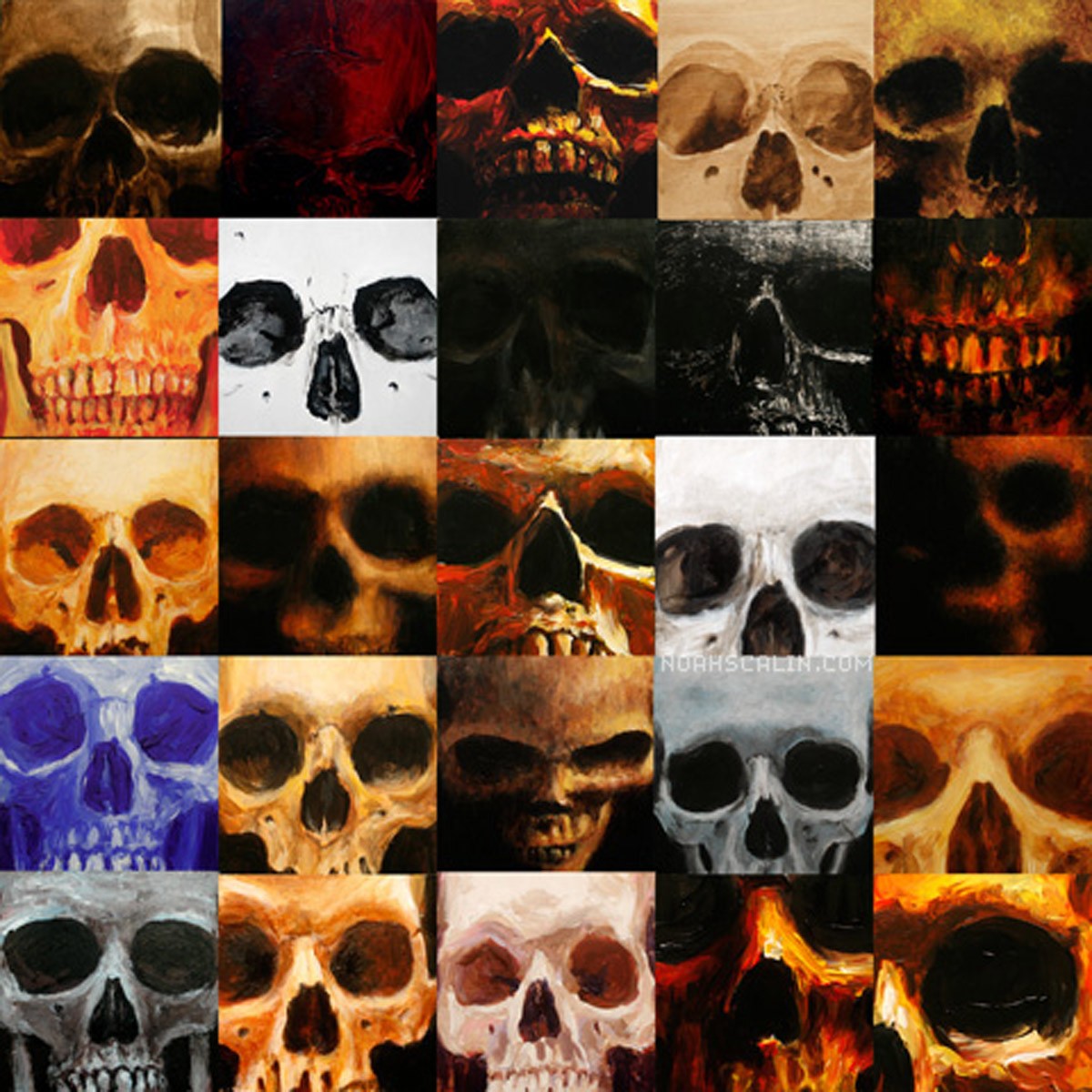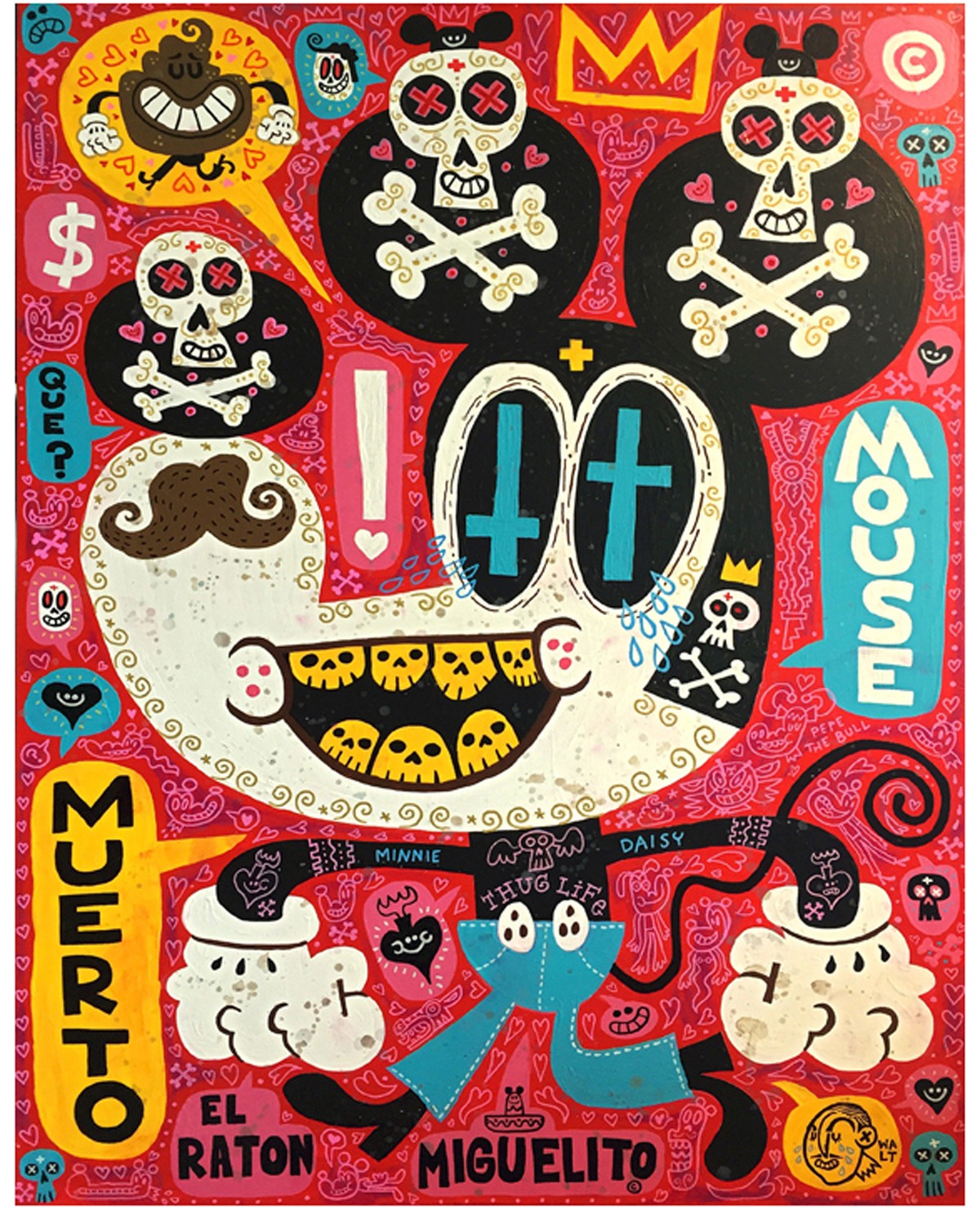
I can't imagine a better series of images to open Huntington Beach Art Center's “Memento Mori: Skulls & Bones In Art” exhibit than Peter Zokosky's triptych Reveal. The oil-on-panel paintings are done in a lush Romantic style: a woman sits in the same pose at a river bank for all three. In the first, her skeleton demurely dips her bones into the water; in the second, the skeleton is now covered with a network of musculature; the third features her in the flesh.
Depending on how you decide to read that—left to right or right to left—she's either assembled by an unseen hand or stripped to the bone. The theme of death, as well as the healthy embrace of it, is at the core of curator Phil Roberts' thorough exhibition, its images reminding us that Halloween does not own the month of October, especially now that its Mexican cousin, Día de los Muertos, is becoming increasingly popular.
Melissa Cooke's graphite-on-paper The Between Spaces: Skull Face offers another riff on Zokosky's theme, this time focusing on decay, with a skull superimposed over a human face, off-kilter, so that the orbitals are on the cheek, making it look as if much of the face has been scooped out and removed, the nasal aperture on the chin a gaping leprosy. Daniel du Plessis' remarkable oil-on-panel Miss me, miss me, miss me has two skeletal hands holding onto a strand of pearls, working as a commentary on both “taking it with you” and the imagined loneliness of the dead. The panel's decorative black frame, a 49-by-38 Gothic monstrosity (and I mean this in a good way) composed of found objects (toy flowers, spiders and flies), amid polymer and epoxy clays, surrounds the image like a funeral wreath.
Local artist Laurie Hassold regularly uses real bones in her arresting organic/fantasy creature sculptures. In Fertile Morte, febrile spurs plunge out of the top of a vaguely aviary skull, the long vertebra connected to it spreading out into more twining appendages. Inside the skull are small wonders waiting for your discovery: eggs and a nest, sea anemone, tiny dinosaurs. Another piece, Pink Frost, is part clam shell, part pink open maw. Its tiny clitoral pearls and spindly legs are reminiscent of the shape-shifting alien in John Carpenter's version of The Thing. Meanwhile, Joshua Harker's complex, 3D-printed polyamide lattice skull in Til Death Do Us Part looks as if it has been knitted out of a sturdy plastic lace, working magic with its visual clichés of marriage: wedding rings, arrows through hearts, chains. His Crania Anatomica Filigre: Binary continues that theme, with its delicate-looking skull and the tinier version nested inside, building on the idea of couples as physically and symbolically bound together.

Maureen Shields' emulsion-and-ink skull designs on vintage porcelain plates are a clever conceit, such as a child's mug with a troll hiding under the chocolate milk. The only thing that would have made them cleverer would have been if they'd been bone china. The 20 acrylic-on-wood panel skulls painted by Noah Scalin, displayed in a grid, are culled from the much-larger 100 Painted Skulls. I'd like to see what an entire wall covered with the glaring brainpans would look like. Marie-Pascale Gautheron's paintings have a visual kinship with Grey's mystical woo-haw, but I couldn't help admiring the vibrancy and craftsmanship of her work, especially her colorful acrylic-on-wood panel Crystal Forest. Featuring an elegant skeleton in a tehuana-style headdress bedecked with laughing calaveras, six-petaled flowers growing out of a human heart held in her hand, moths and fireflies flitting about her, it provides a searing visual. Jorge Gutierrez's graffiti-inflected, acrylic portraits of Mickey Mouse (Super Muerto Mouse) and Harry Potter [La Del Niñito Brujo (Horacio de las Ollas aha Harry Potter)] and Dora the Explorer [Original Gangsta (Dora La Sad Eyes)] are only tangentially related to the theme of the show—there are skulls in them—but they're a welcome addition. A joy to look at and a mood leavener to the weighty subject matter displayed around them; they're as big, bright and beautiful as his animated film, The Book of Life.

Several Día de los Muertos altars close the exhibition in the last gallery. A couple have been adorned with fake food (to avoid bugs), colorful papel picado, flickering electric candles, personal portraits and mementos, while another has been left open to the public to decorate. It seems a fitting place to add a personal celebration, honoring a loved one by helping them symbolically through that most difficult of all spiritual journeys . . . and doing so amid an emotional, moving, contemplative amount of truly striking artwork.
“Memento Mori: Skulls and Bones In Art” at Huntington Beach Art Center, 538 Main St., Huntington Beach, (714) 374-1650; www.huntingtonbeachartcenter.org. Open Tues.-Thurs., noon-8 p.m.; Fri., noon-6 p.m.; Sat., noon-5 p.m.. Through Nov. 5. Artist and film director Jorge Gutierrez discusses and screens his film The Book of Life. Oct. 29, noon-4 p.m. Free.
Dave Barton has written for the OC Weekly for over twenty years, the last eight as their lead art critic. He has interviewed artists from punk rock photographer Edward Colver to monologist Mike Daisey, playwright Joe Penhall to culture jammer Ron English.


I recently tried CBD gummies from this website https://www.cornbreadhemp.com/products/cbd-sleep-gummies after the prime time and was pleasantly surprised past the results. Initially skeptical, I found that it significantly helped with my anxiety and sleep issues without any noticeable side effects. The lubricator was easy to put to use, with nitid dosage instructions. It had a indulgent, earthy liking that was not unpleasant. Within a week, I noticed a patent increase in my blanket well-being, hunch more serene and rested. I comprehend the regular technique to wellness CBD offers and representation to pursue using it.